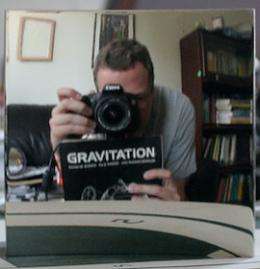Artist's inspiration: How robot soccer led to a mirror that reflects your true face

When you look in a mirror, you see an image of yourself in reverse. But one odd mirror invented by mathematics professor Dr. R. Andrew Hicks at Drexel University shows your true face without reversing its image. That mirror is now on display as part of an art exhibition in New York City's Room East gallery by artist Robin Cameron, through December 9.
Hicks's unusual mirrors gained national attention in summer of 2012 when one of those inventions, a driver's side mirror that eliminates the blind spot with minimal distortion, received a U.S. Patent.
Other novelty mirrors show a non-reversed image to a viewer by placing two mirrors at right angles, so that looking at the glass shows a simple reflection of the reflection. Hicks's non-reversing mirror is different, in that it is a single, smooth curved piece of glass that shows a non-reversed image.
Cameron found inspiration in Hicks's story when she discovered it through online research. Hicks and Drexel subsequently loaned her the non-reversing mirror for use in her group of artworks entitled "P-R-O-C-E-S-S-E-S."
"The mirror specifically relates to this particular grouping of work because it is about process. I wanted to know more about what leads someone to make a non-reversing mirror," Cameron said.
Hicks became an inventor of mirrors via a background in hobbyist electronics tinkering, formal education in mathematics and postdoctoral work in computer science, before continuing the work as a professor in Drexel's College of Arts and Sciences. Hicks began mathematical manipulations of reflective surfaces when developing vision control mechanisms for soccer-playing robots, using curved mirrors atop the robots' heads to give a 360-degree view. He developed computer algorithms to subtly manipulate the angles of curved mirror surfaces so that distortions in the reflection are precisely controlled. The precise manipulations change the directions light rays are reflected off of the surface in a manner analogous to changing the angles of millions of tiny facets on a flattened disco ball, but decreasing the size of each facet until a smooth surface results.
"I see some similarities to the work that I do and the work that Andrew does, in terms of following what interests you and creating something new." Cameron said.
Beyond its value as an object of art, Hicks considers the non-reversing mirror an interesting novelty and is still looking for practical applications. "I always thought it would make a great toy," Hicks said.
The mirror is popular when he shows it at talks and in classes. "People often think that such a thing should be impossible, and they want to hold it and look at it from different angles," he said. "It's sort of as if some object from an M.C. Escher print existed in the real world."
Provided by Drexel University




















